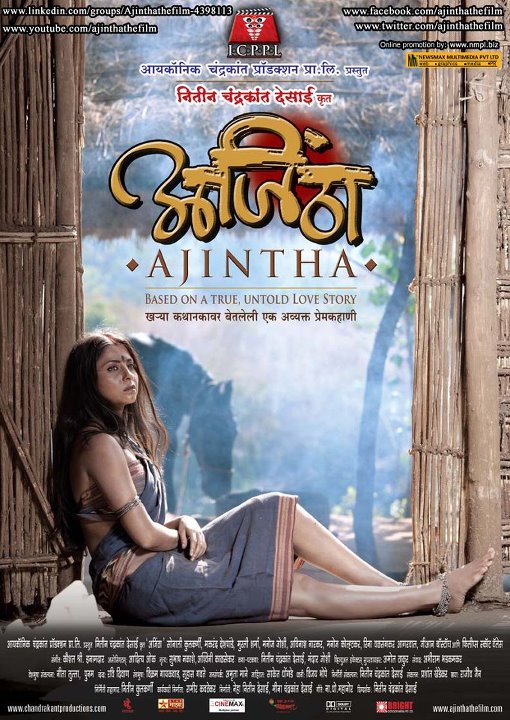Direction: Nitin Chandrakant Desai
Production: Neha Nitin Desai, Meena Chandrakant Desai
Writers: Nitin Chandrakant Desai, Mandar Joshi
Cast: Sonalee Kulkarni, Philip Scott Wallace, Manoj Kolhatkar, Avinash Narkar, Murli Sharma, Makrand Deshpande, Reena Aggarwal, Manoj Joshi
Music: Kaushal S. Inamdar
Rating: * * * ½
Plot: During a hunting expedition in 1819, British officer Captain James Smith (Jian Bostoch) accidently discovers the Buddhist caves of Ajanta which date back to the Satavahana dynasty in the 200th Century B. C. Smith is astonished by the beauty of the pictures inside the caves. Later on in 1844, the Britishers send Captain Robert Gill (Philip Scott Wallace), a top quality painter, to recreate the paintings on canvas to enlighten the world about the great Ajanta caves.
As soon as Gill arrives at Lenapur for his task, he falls in love with the cave paintings and the surroundings. In recreating the paintings, Gill gets much needed help from Paro (Sonalee Kulkarni), a girl from the local tribal community. As fate would have it, the couple falls in love. But will the society accept such a relationship?
Review: Love is a feeling that is devoid of language barriers. It really doesn’t matter if you can’t understand a word of what a person speaks if your heart has struck a chord with him or her. Nitin Chandrakant Desai’s Ajintha explores this pure form of love while offering a visually stunning cinematic experience. Naturally, due to such genre, the film caters more to the art-house audience.
The subject of Ajanta caves provides plenty of scope for Desai to showcase his artistic skills, which he does brilliantly in creating sets similar to real caves. The images and the architecture inside and outside of it put you in awe of the art. Add to this, Rajeev Jain’s breathtaking and artistic cinematography (especially while capturing waterfalls and landscapes) and you get nothing less than a visual treat, which has the capacity to impress the audience world over.
 As mentioned earlier, there is a huge language and cultural barrier between Paro and Gill. Therefore, it can be very difficult for the writers to show love blossoming between them as they can’t use proper dialogues. This difficult task is managed well as the love story between the couple is made believable with the use of intelligent situations and circumstances. Due to this, the audience instantly starts feeling for the characters. In between, explanation of the philosophy related to the cave paintings and Indian mythology adds further colors.
As mentioned earlier, there is a huge language and cultural barrier between Paro and Gill. Therefore, it can be very difficult for the writers to show love blossoming between them as they can’t use proper dialogues. This difficult task is managed well as the love story between the couple is made believable with the use of intelligent situations and circumstances. Due to this, the audience instantly starts feeling for the characters. In between, explanation of the philosophy related to the cave paintings and Indian mythology adds further colors.
The second half deals more with the circumstances of the love story of the couple. It is this part that will test the patience of a section of the audience due to the inclusion of a number of songs. Even the duration of some scenes could have been shortened. But if you are an admirer of such genre, it shouldn’t bother you much, especially after witnessing the moving climax that extends till the ending credits.
It’s necessary to mention that a good part of the movie is in English. Although there are sub-titles provided during English dialogues, it is doubtful whether the Indian audience is used to reading them while watching a movie.
Kaushal S. Inamdar’s compositions and N D Mahanor’s lyrics add more soul to the proceedings. Neeta Lulla also deserves praise for creating costumes that look believable to be of that era.
Sonalee Kulkarni moulds herself brilliantly in the role of Paro and expresses every emotion with ease. She impresses with her dancing skills too. This will surely be a talked about performance from her career even after decades. British actor Philip Scott Wallace deserves equal praise for a mature act. The chemistry between both the actors is appealing.
Manoj Kolhatkar gives a fine act (Jalal-Ud-Din) and so does Avinash Narkar (Pandit). Murli Sharma and Makarand Deshpande play the bad guys with ease. Reena Aggarwal provides good support. Manoj Joshi and Jian Bostoch excel in cameos.
Overall, Ajintha is a picturesque saga defining the true meaning of love. The film has a chance of succeeding at the box-office.